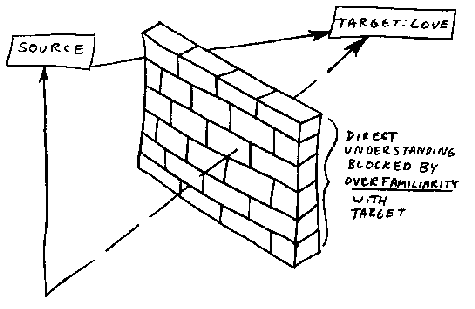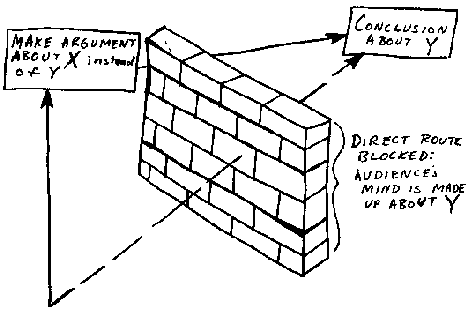Return to MODULE PAGE
Metaphors & Defamiliarization
Clay Beckner: Author
| Habitualization devours objects, clothes, furniture, one's wife, and the fear of war. . . Art exists to help us recover the sensation of life, it exists to make us feel things, to make the stone stony. The end of art is to give a sensation of the object as seen, not as recognized. The technique of art is to make things 'unfamiliar,' to make forms obscure, so as to increase the difficulty and duration of perception. --Victor Schklovsky |

The cognitive prison
Metaphors do not simply make accessible unfamiliar or intangible things; they also help to break us out of familiar modes of perception. Metaphors defamiliarize using a mechanism similar to that of familiarization: direct perception of a thing is unavailable to us, but here the barrier on perception is familiarity, rather than unfamiliarity. By providing new descriptions of things, metaphor provides one way of breaking us out of rigid and confining ways of viewing things.

It is perhaps incorrect to say that familiarity completely blocks our understanding of things; rather, it seems that familiarity simply limits our understanding. From this viewpoint, language might be said to be reminiscent of the parable of the blind men and the elephant, in which three blind men encounter an elephant for the first time:
Since they did not know even the form or shape of the elephant, they groped sightlessly, gathering information by touching some part of it. Each thought he knew something, because he could feel a part. . .The man whose hand had reached an ear said: 'It is a large, rough thing, wide and broad, like a rug.' One who had felt the trunk said: 'I have the real facts about it. It is like a straight and hollow pipe, awful and destructive.' One who had felt its feet and legs said: 'It is mighty and firm, like a pillar.' Each had felt one part out of many. Each had perceived it wrongly.--Tales of the Dervishes
Language provides a parallel with this parable; our descriptions (whether through literal language or an overfamiliar metaphor) provide only one perspective on a thing. Metaphor provides one means of 'breaking through the wall' to select a new perspective out of the many that are possible. It seems, then, that familiarization and defamiliarization are not mutually exclusive activities. Rather, defamiliarization is itself a type of familiarization, in which we realize that our habitual descriptions are not entirely sufficient for revealing the nature of things.

PT's current approach to metaphor makes use of simulations, which is a promising approach for both familiarizing and defamiliarizing metaphors. For a discussion of familiarizing metaphors, click here.
Closely related to defamiliarizing metaphors are many arguments by analogy. Metaphor and analogy resemble one another enough that it is, in fact, often difficult to distinguish between the two. One possible distinction is to say that metaphors are indirect descriptions, whereas analogies are indirect arguments. (But again, the distinction between description and argumentation is itself quite fuzzy.) One way to describe arguments by analogy is as a circumvention of an opponent's familiarity with a subject. The analogy makes an argument about a different subject instead, and then applies the principle in the new case to the familiar case.




